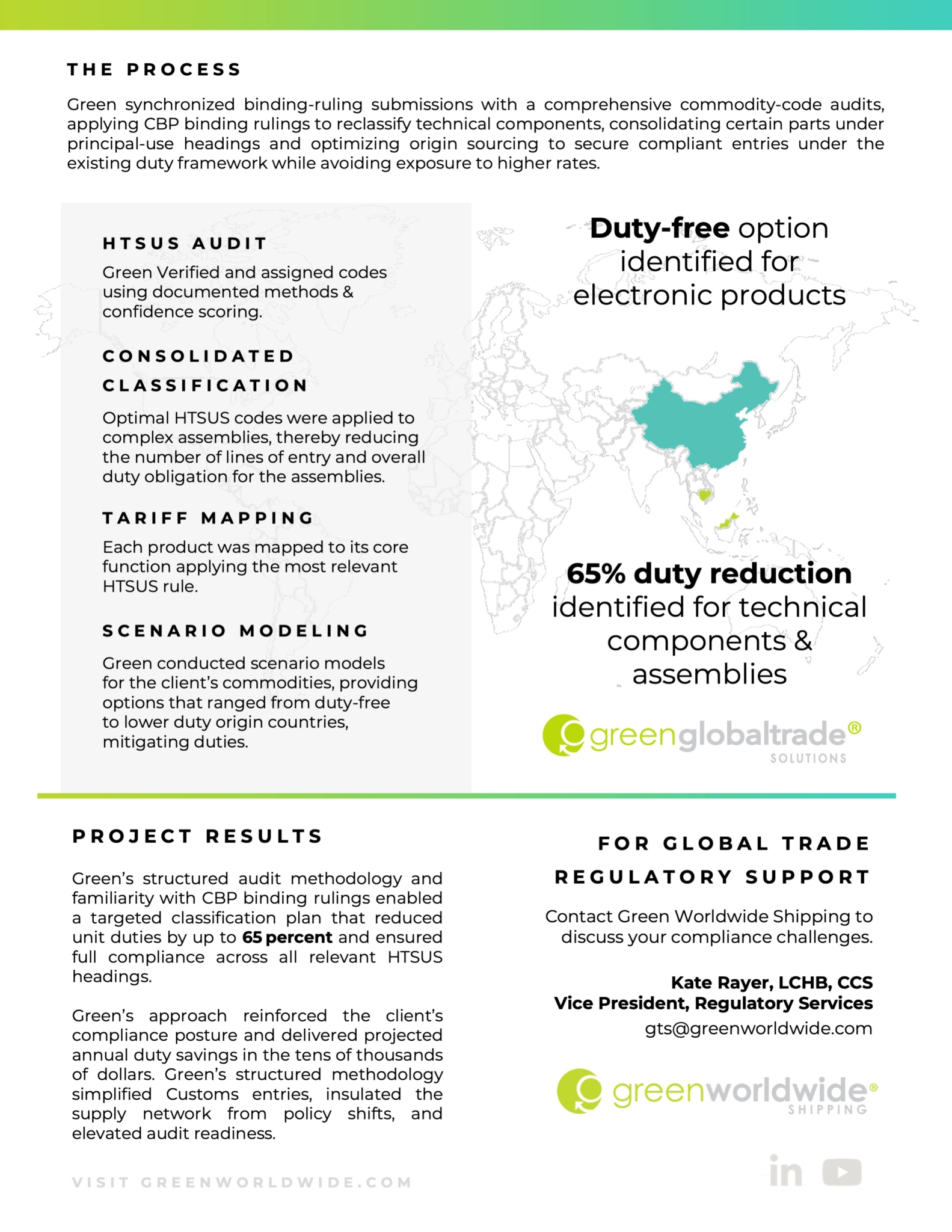“Green’s experienced licensed Global Trade Solution team provided a thorough audit of our HTSUS codes and offered actionable solutions to ensure we remain compliance while mitigating duty exposure for our global enterprise.”
TESTIMONIAL | SPORTS EQUIPMENT CLIENT
case study
WHY DOES CUSTOMS CLASSIFICATION MATTER IN THE CURRENT U.S. TRADE ENVIRONMENT?
For U.S. importers, the past year has shown how quickly trade policy can reshape business costs. New tariffs, reciprocal measures, and shifts in Section 232 and 301 duties have led many importers and manufacturers to reassess the classification and sourcing of imported products. An evolving U.S. trade policy has transformed Customs compliance from a routine function to one that directly impacts pricing, available supply, and business competitiveness. Ensuring that imports use correct Harmonized Tariff Schedule of the United States (HTSUS) classification provides strategic tariff mitigation. With the potential to improve a company’s bottom line.
HOW DID GREEN WORLDWIDE SHIPPING CONDUCT THE AUDIT?
When a global sports equipment importer asked for help reviewing its HTSUS classifications, Green Worldwide Shipping’s (Green) Global Trade Solutions team approached the project as both a compliance exercise and an operational study. Licensed Customs professionals examined every product line — textile enclosures, steel frames, modular assemblies, and radar-based components — against CBP binding-ruling precedent. Each classification was verified through documentation and confidence scoring, then modeled across multiple origins to test how different sourcing decisions would influence duty exposure. The outcome was a data-backed roadmap designed to correct misclassifications and prevent them from recurring.
WHAT DID GREEN WORLDWIDE SHIPPING’S CLIENT AUDIT REVEAL?
The review confirmed that several technical assemblies had been reported under headings carrying layered tariff obligations. By tracing each product to its principal use and aligning it with the most defensible HTSUS chapter, Green identified legal opportunities to lower exposure without compromising compliance. The process also simplified Customs entries by consolidating related components into unified classifications, reducing complexity for both internal teams and CBP reviewers.
WHAT IMPACT DID GREEN’S RECOMMENDATIONS HAVE ON THE CLIENT’S COMPLIANCE PROGRAM AND LANDED COSTS?
After implementing the revised classifications, the importer achieved a nearly 65% reduction in duty exposure for key assemblies. More importantly, the company now held a defensible classification framework that could be adapted to future tariff changes. The audit reinforced the client’s compliance readiness, reduced their internal administrative workload, and positioned the importer to respond quickly when new trade measures take effect.
Companies that prioritize structured HTSUS reviews and scenario modeling are better equipped to protect margins, ensure compliance, and respond to future trade shifts.
For more information, contact [email protected].


BOTTOM LINE, WE SPEAK FREIGHT. ISN’T IT TIME TO MOVE FREIGHT FORWARD?
Stay up-to-date on freight news by following us on LinkedIn. For continuous updates, make sure to check out our website at greenworldwide.com.






